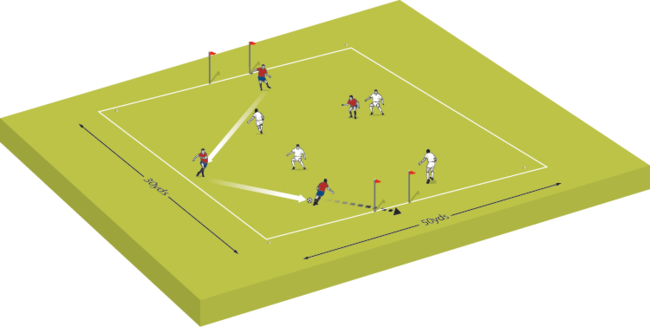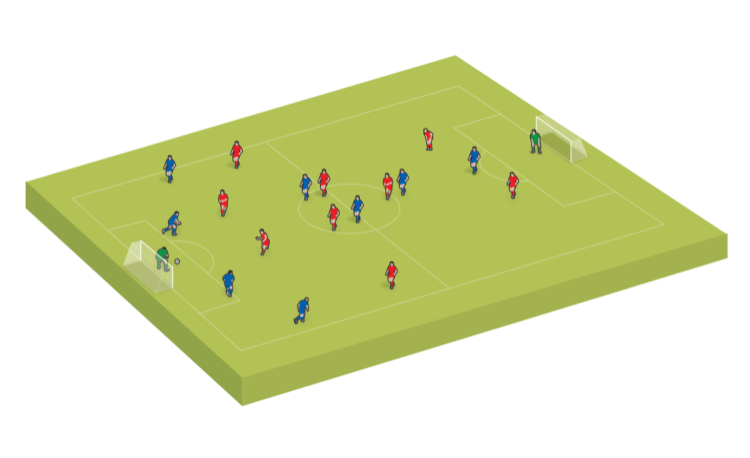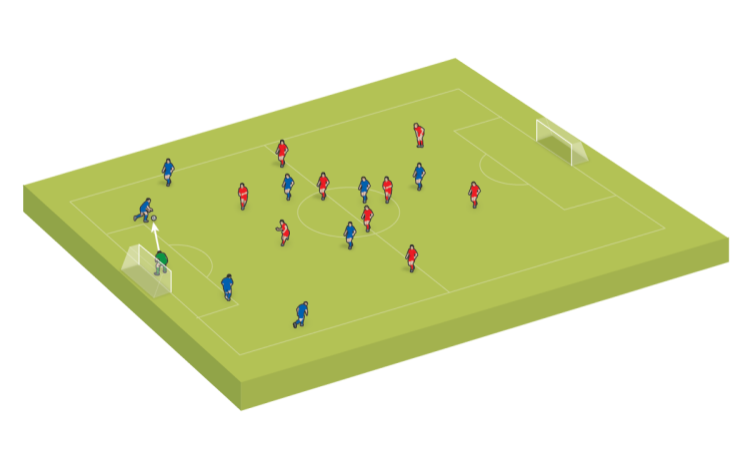Develop players with Dutch 4v4
‘The Dutch 4v4’ is a small-sided game blueprint that has been at the heart of producing a vast array of talented individuals. It is the Dutch way to pick out problems during the match, create similar training models, and use them to develop the players.
‘The Dutch 4v4’ is a small-sided game blueprint that has been at the heart of producing a vast array of talented individuals. The philosophy behind it is three-fold – it maximises involvement in soccer situations because there is rarely an escape from the action, and it represents something that is at the heart of Dutch coaching – that training exercises are always based on situations that occur in matches.
It is the Dutch way to pick out problems during the match, create similar training models, and use them to develop the players. Finally, a 4v4 game is so well balanced it can provide two different threads of research – one for coaching and one for scouting.
Set up
The 4v4 game is played in an area measuring 50x30 yards, with a goal at each end two yards wide. There are no keepers. Players operate in a small unit. This means they can switch from defence to attack, and from wide areas to the middle, in only a few paces. After a goal, play restarts with a goal kick or a dribble from the goal line. All balls that go out to the side are tapped back into play with a pass to a team mate, while free-kicks are indirect. There are no offsides and penalties are taken from the halfway line.
The theory
Using this means you have created the smallest possible formation which still has all three lines: attack, midfield and defence. But we still see all elements of ground play, combinations, and the notion that the ball should be the thing doing the work. Although creativity is important, team play is the biggest element.
The practice
Four-a-side matches are relentlessly intensive, meaning that players get used to cooperating with each other, can fine-tune visual and tactical aspects, and get used to playing at high intensity. Because scenarios develop so quickly, children learn the dos and don’ts of the game through constant repetition.
4v4 for training
As discussed, all three specialisms are tested. In addition, we coach the players to take maximum advantage of one-twos and triangle combinations, thus develop team play.
4v4 for scouting
Normally a player will start to learn he is part of a team at the age of 12 – it’s the age at which his social skills begin to flourish. However, when we see a very young player - say between the ages of 5 and 7 - using combinations in 4v4 it offers a strong indication that we are looking at a talented individual.
As part of the academy process
In Holland’s professional academies training is set up in modules, of which 4v4 is one. Each module showcases tasks which develop particular skills. Four or more trainers each give a particular exercise, and every 7-10 minutes players rotate to the next task. Over the year all the exercises together bring the player to a certain level designed to prepare him for an 11v11 match. The development of the players is monitored all the time, with improvements (or lack of improvement) discussed and evaluated. At the end of the season players are either invited for the next year or have to leave the academy.
The legacy
All youth coaches start with the principle of 4v4 and develop young players’ games from there. In the time a player is part of a professional youth academy, our focus is never on competition. The goal is to make the team better as a whole, while focusing added attention on those extraordinary one or two talents that might be able to join the first team. I don’t believe the Dutch setup for professional soccer academies is matched anywhere in the world. The attention to detail in terms of coaching is as important as it is to the players. As a trainer at a youth academy, I work about 40-60 hours a week. Over years to come new technology will play a greater part during academy education in the sense of monitoring improvement rather than specifically improving a player – that’s still for the coach to do! In future, it will also become more difficult for a player to move into coaching at the end of his career. This is because young footballers are now hanging up their boots to begin coaching – some as young as 15. That means former pros coming into the game have two decades’ worth of tutoring to catch up on.
Newsletter Sign Up
Coaches Testimonials

Gerald Kearney, Downtown Las Vegas Soccer Club

Paul Butler, Florida, USA

Rick Shields, Springboro, USA

Tony Green, Pierrefonds Titans, Quebec, Canada
Subscribe Today
Discover the simple way to become a more effective, more successful soccer coach
In a recent survey 89% of subscribers said Soccer Coach Weekly makes them more confident, 91% said Soccer Coach Weekly makes them a more effective coach and 93% said Soccer Coach Weekly makes them more inspired.
*includes 3 coaching manuals
Get Weekly Inspiration
All the latest techniques and approaches
Soccer Coach Weekly offers proven and easy to use soccer drills, coaching sessions, practice plans, small-sided games, warm-ups, training tips and advice.
We've been at the cutting edge of soccer coaching since we launched in 2007, creating resources for the grassroots youth coach, following best practice from around the world and insights from the professional game.







